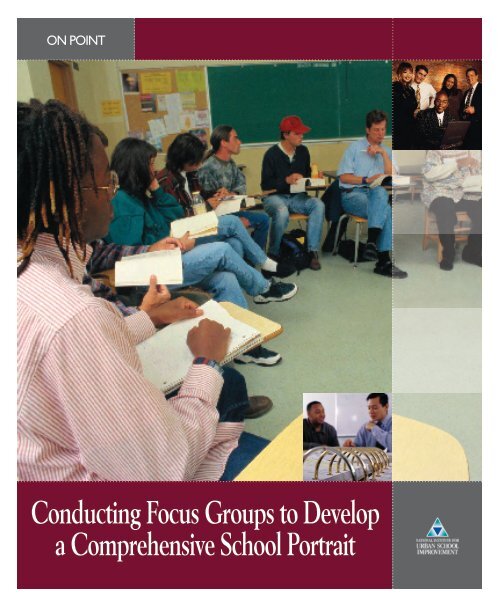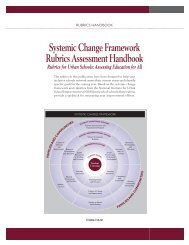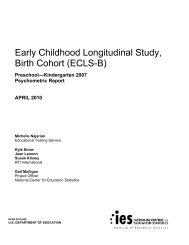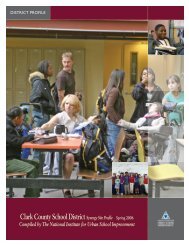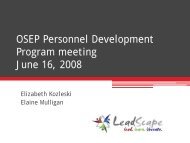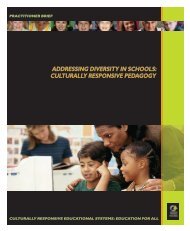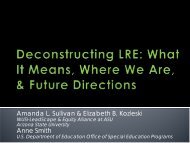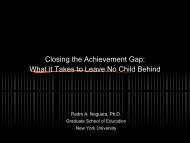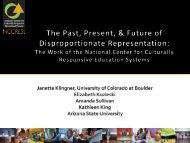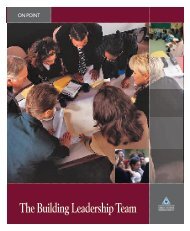Conducting Focus Groups to Develop a ... - NIUSI Leadscape
Conducting Focus Groups to Develop a ... - NIUSI Leadscape
Conducting Focus Groups to Develop a ... - NIUSI Leadscape
Create successful ePaper yourself
Turn your PDF publications into a flip-book with our unique Google optimized e-Paper software.
ON POINT<br />
<strong>Conducting</strong> <strong>Focus</strong> <strong>Groups</strong> <strong>to</strong> <strong>Develop</strong><br />
a Comprehensive School Portrait
The mission of the National Institute for Urban School Improvement<br />
is <strong>to</strong> partner with Regional Resource Centers <strong>to</strong> develop powerful networks<br />
of urban local education agencies and schools that embrace and implement a<br />
d a t a - b a s e d , c o n t i nuous i m p rove m e n t appro a c h for i n c l u s i ve p r a c t i c e s .<br />
Embedded within this approach is a commitment <strong>to</strong> evidence-based practice<br />
in early intervention, universal design, literacy and positive behavior supports.<br />
The Office of Special Education Programs (OSEP), of the U.S. Department of<br />
Education, has funded <strong>NIUSI</strong> <strong>to</strong> facilitate the unification of current general and<br />
special education reform efforts as these are implemented in the nation’s urban<br />
school districts. <strong>NIUSI</strong>’s creation reflects OSEP’s long-standing commitment <strong>to</strong><br />
improving educational outcomes for all children, specifically those with<br />
disabilities, in communities challenged and enriched by the urban experience.<br />
Great Urban Schools: Learning Together Builds Strong Communities
1<br />
ON POINT SERIES<br />
<strong>Conducting</strong> <strong>Focus</strong> <strong>Groups</strong> <strong>to</strong> <strong>Develop</strong><br />
a Comprehensive School Portrait<br />
National Institute for Urban School Improvement<br />
Arizona State University<br />
In Collaboration with:<br />
The Colorado Department of Education<br />
Peak Parent Center<br />
The Silc Road<br />
©2005 <strong>NIUSI</strong>
2<br />
WHAT ARE FOCUS GROUPS?<br />
<strong>Focus</strong> groups are an effective means of<br />
collecting qualitative information that can be<br />
used <strong>to</strong> guide improvement planning and<br />
efforts. A focus group is usually conducted with<br />
8-10 participants who are connected with the<br />
school and have information about what is<br />
happening there. Guided by a modera<strong>to</strong>r, these<br />
individuals discuss selected <strong>to</strong>pics or answer<br />
open-ended questions. Discussions and/or<br />
answers are recorded during the session and<br />
later analyzed for common themes. The process<br />
can lead <strong>to</strong> rich conversation and meaningful<br />
insights in<strong>to</strong> issues. <strong>Focus</strong> groups allow Building<br />
Leadership Teams (BLTs) <strong>to</strong> explore and<br />
understand attitudes, opinions, feelings and<br />
behaviors of staff, family, community members<br />
and students as they address general or specific<br />
issues related <strong>to</strong> the school community. The<br />
result is clearer identification of both strengths<br />
and needs. The technique can also assist BLTs as<br />
they compile their school profiles by providing a<br />
better understanding of quantitative finding<br />
such as test and survey results.<br />
FOCUS GROUPS<br />
• go beyond typical surveys in providing<br />
rich, insightful data<br />
• provide for participant interaction that<br />
draws out varying perspectives<br />
• allow for expanded discussion around<br />
specific issues<br />
• result in quick turnaround from<br />
implementation <strong>to</strong> findings<br />
HOW DO FOCUS GROUPS<br />
WORK?<br />
<strong>Develop</strong>ing the Research Objectives<br />
and Questions/Topics Building<br />
Leadership Teams can use focus groups <strong>to</strong><br />
find out almost anything about the climate,<br />
day-<strong>to</strong>-day operations, and individual<br />
perceptions of the school. To obtain these<br />
outcomes, it is important for BLTs <strong>to</strong> identify<br />
what is currently known about the school<br />
and specific areas where additional<br />
information may be beneficial. This<br />
information will be used <strong>to</strong> develop the<br />
research objectives. The BLT will then need<br />
<strong>to</strong> formulate a set of questions or <strong>to</strong>pic<br />
statements that will guide the discussion.<br />
The questions or <strong>to</strong>pics may be broad <strong>to</strong> elicit<br />
opinions or attitudes about the general status<br />
of the school. Examples of broad prompts<br />
might look like:<br />
Tell me about this school. What kinds of<br />
students go <strong>to</strong> this school? How do<br />
students learn at this school? Who makes<br />
the decisions in this school?<br />
Specific questions or <strong>to</strong>pics may be aimed at<br />
gathering information about discrete subjects.<br />
Such questions might be:<br />
How effective is the in-school suspension program<br />
for students with ongoing behavior challenges?<br />
Do parents understand how growth <strong>to</strong>ward<br />
the district content standards is assessed?
3<br />
What can adults do <strong>to</strong> help students stay<br />
in school?<br />
How effective has the reading program been<br />
for students with specific reading disabilities?<br />
Selecting a Modera<strong>to</strong>r Once created,<br />
these questions or discussion <strong>to</strong>pic statements<br />
will be used by the modera<strong>to</strong>r who will<br />
conduct the focus group sessions. The role of<br />
the modera<strong>to</strong>r is very important <strong>to</strong> the success<br />
of getting the information the BLT desires.<br />
Therefore, careful consideration must go in<strong>to</strong><br />
choosing a modera<strong>to</strong>r. The individual selected<br />
will need <strong>to</strong> be unbiased <strong>to</strong>ward the outcome<br />
of group findings and have no personal agenda<br />
around the <strong>to</strong>pic being researched that might<br />
skew the interviewing and analysis process.<br />
Greenbaum (1998) and Vaughn, Schumm and<br />
Sinagub (1996) have cited the following<br />
characteristics as desirable in a modera<strong>to</strong>r,<br />
whether an outside person or someone within<br />
the school community is sought for the roles.<br />
•<br />
•<br />
•<br />
•<br />
•<br />
•<br />
•<br />
•<br />
effective interviewing skills<br />
does not project an attitude of expertise<br />
of <strong>to</strong>pic<br />
superior listening skills<br />
excellent short term audi<strong>to</strong>ry memory<br />
well organized<br />
quick learner<br />
high energy level<br />
appropriate social skills<br />
The modera<strong>to</strong>r will work with the BLT <strong>to</strong><br />
determine the focus group participants and<br />
the logistics (dates, times, and location). It is<br />
important that each group be asked the same<br />
set of questions or <strong>to</strong>pics for discussion so that<br />
responses can be compared.<br />
Selecting Group Participants It is<br />
recommended that at least two focus groups<br />
of representatives from a particular segment<br />
of the school should be conducted <strong>to</strong> help<br />
validate the accuracy of findings. The<br />
participants in each focus group should have a<br />
shared trait or experience on which the<br />
discussion can build. This might include<br />
students who are at certain grade levels,<br />
educa<strong>to</strong>rs who have been enforcing school<br />
policy, families of students attending the<br />
school, etc. It will be important when<br />
assigning or recruiting participants <strong>to</strong> ensure a<br />
representative sample from the school.<br />
Identifying the most appropriate participants<br />
may not always be easy. As just suggested, the<br />
group should probably be somewhat<br />
homogeneous as <strong>to</strong> their common role in the<br />
school community. If a group is <strong>to</strong>o<br />
heterogeneous (e.g., teachers, administra<strong>to</strong>rs<br />
and parents in the same group), the impact on<br />
individual contributions may be considerable.<br />
Conversely, if the group is ‘loaded’ with<br />
participants known <strong>to</strong> share a common<br />
opinion, diverse perspectives will not be<br />
revealed. A selection procedure that is at least<br />
somewhat of a random sampling of the target<br />
group is recommended.<br />
The number of participants in a focus group<br />
may vary. The optimum number is probably
4<br />
between 6 and 10, however, some researchers<br />
conduct sessions with up <strong>to</strong> 15 participants.<br />
HOW DO WE CONDUCT A<br />
FOCUS GROUP?<br />
Planning for the Session The quality<br />
of output from the focus groups will be largely<br />
dependent upon advanced planning. Addressed<br />
should be such things as the recruitment of the<br />
appropriate participants, the preparation of a<br />
“discussion guide,” and the determination of<br />
how the information will be recorded.<br />
The modera<strong>to</strong>r’s guide should outline some<br />
basic components of the session, such as:<br />
• Introduction (welcome, purpose,<br />
session procedures)<br />
• Terms <strong>to</strong> be clarified<br />
• Key questions and possible<br />
follow-up probes<br />
• Member check (determine/clarify how<br />
each member perceives the issues)<br />
• Closing statements (identify major<br />
theme/s from the responses, request<br />
anonymity of the information, express<br />
thanks, etc.)<br />
<strong>Focus</strong> groups may last anywhere from 30<br />
minutes <strong>to</strong> two hours. Regardless of the<br />
length of the session, it is important that the<br />
modera<strong>to</strong>r ensures careful tracking of the<br />
time (perhaps planning for a certain number<br />
of minutes per question) and detailed<br />
recording of the discussion or further analysis.<br />
The modera<strong>to</strong>r may plan <strong>to</strong> take notes on<br />
member responses, both verbal and<br />
nonverbal, as well as noting key issues that<br />
may emerge during the session. However, if<br />
the focus group session is not tape recorded,<br />
it is important <strong>to</strong> arrange for at least two<br />
other individuals <strong>to</strong> record responses in<br />
order <strong>to</strong> increase the accuracy of the<br />
information. (See the <strong>Focus</strong> Group Reporting<br />
Form provided on the last page.)<br />
Things <strong>to</strong> SAY before you BEGIN: The<br />
purpose of this focus group is <strong>to</strong> gather<br />
information that will help us understand<br />
_______. This focus group will last for ______.<br />
Whatever you say here will remain<br />
confidential. That means that we won’t reveal<br />
what was said here by individual name,<br />
although we will share the information that<br />
you give in general. It also means that all of<br />
you agree not <strong>to</strong> share the comments made<br />
here with others outside this group. It is<br />
extremely important that we all understand<br />
the nature of this confidentiality since it will<br />
help us <strong>to</strong> get as clear and honest a picture of<br />
your school as possible.<br />
We will tape this focus group and transcribe<br />
the tape. Where needed, fictional names will<br />
be substituted for the names mentioned here.<br />
Since each of your perspectives is important,<br />
we need <strong>to</strong> make sure that everyone gets a<br />
chance <strong>to</strong> express their opinions and no one<br />
takes <strong>to</strong>o much of the air time. I will take<br />
responsibility for time keeping and making
5<br />
sure that we address all of the questions. Use<br />
your best strategies <strong>to</strong> express your opinions<br />
without making others feel uncomfortable.<br />
understanding about what the participant<br />
said. Figure I below is an example of how this<br />
process might play out.<br />
Things <strong>to</strong> SAY at the END: Thank you for<br />
your participation; your input will be<br />
invaluable. Remember that what has been<br />
shared here is <strong>to</strong> be kept confidential.<br />
Questioning Strategies The modera<strong>to</strong>r<br />
should ask participants general questions<br />
when starting a discussion around a certain<br />
<strong>to</strong>pic then move <strong>to</strong> questions that will further<br />
detail or expand the answers of the<br />
participants <strong>to</strong> elicit responses that are more<br />
comprehensive. These general questions<br />
would include basic who, where, when, why,<br />
and how questions. The modera<strong>to</strong>r can<br />
encourage participants <strong>to</strong> provide further<br />
insight in<strong>to</strong> the issue by asking elaboration or<br />
clarification questions. These probes can be<br />
used <strong>to</strong> make sure that there is complete<br />
HOW DO WE ANALYZE THE<br />
INFORMATION?<br />
There are several ways in which the data<br />
gained from the focus group can be analyzed for<br />
use by the BLT. Because the data collected is<br />
qualitative in nature, modera<strong>to</strong>r/recorder notes<br />
and impressions, as well as tape transcription for<br />
additional analysis are vital <strong>to</strong> the process.<br />
Transcription will depend upon available<br />
resources. Secretarial staff, BLT member(s)<br />
who have primary responsibility for<br />
evaluation, or other designated persons who<br />
will carry out the research may transcribe the<br />
tapes. The following steps are useful in<br />
analyzing responses:<br />
FIGURE I: When discussing the area of school safety, the<br />
modera<strong>to</strong>r might ask a group of middle school students:<br />
general<br />
question<br />
Detail Probes<br />
or Expanders<br />
Clarification<br />
or Elaboration<br />
Do<br />
students<br />
feel safe<br />
at thiS<br />
SCHOOL?<br />
What do teachers do <strong>to</strong> make<br />
you feel safe?<br />
Tell me how that makes you<br />
feel safer?<br />
Are there areas in the school<br />
you feel safer?<br />
What does that look like?<br />
Tell me a little more about<br />
how they do that.<br />
You said the way that your classrooms<br />
are set up made you feel safer. Could<br />
you explain what that looks like?
6<br />
Describe the Participants In order for<br />
the individual doing analysis and others who<br />
may use data results <strong>to</strong> better understand the<br />
information, it will be important for the<br />
modera<strong>to</strong>r <strong>to</strong> provide a profile of those who<br />
participated in the group. How the individuals<br />
are connected <strong>to</strong> the school (students,<br />
families, community members, etc.) and<br />
simple demographic information such as<br />
grade level, gender, language abilities, etc., can<br />
provide functional descriptions.<br />
Summarize Key Ideas It is useful <strong>to</strong> for<br />
the modera<strong>to</strong>r <strong>to</strong> summarize key ideas<br />
immediately after the focus groups, both <strong>to</strong><br />
frame the experience and <strong>to</strong> determine the<br />
initial, central categories for data analysis.<br />
When writing these notes, the modera<strong>to</strong>r<br />
should consider:<br />
• Big ideas that seemed <strong>to</strong> emerge<br />
• Words that were used and their meaning<br />
• Context in which comments were made<br />
• Consistency or patterns of responses<br />
Write Impressions of<br />
Transcriptions / Notes The next<br />
step in analysis is <strong>to</strong> review the transcriptions<br />
of the group discussion. When reading the<br />
transcripts or notes from the group, it is<br />
useful for the individual doing analysis <strong>to</strong><br />
write interpretive thoughts about the<br />
discussion in the margins of the notes.<br />
This step can reveal how group dynamics<br />
affected participants interactions and<br />
responses as well how the discussion<br />
unfolded, elements that may not be captured<br />
when just coding the data.<br />
Describe Each Category Based upon<br />
the big ideas identified, the modera<strong>to</strong>r and/or<br />
individual doing the analysis will need <strong>to</strong> define<br />
what the central ideas, or categories, mean. This<br />
step helps <strong>to</strong> clarify the process of analyzing and<br />
sorting statements in the discussion notes in<strong>to</strong><br />
the most appropriate categories.<br />
Consider the following example: One of the<br />
categories the modera<strong>to</strong>r identified from a<br />
focus group was after-school activities. The<br />
description assigned <strong>to</strong> this category was as<br />
follows: After-School Activities includes any<br />
activities that happen at the end of the<br />
student’s school day (2:45 p.m. or later).<br />
Code the Data After the tapes have been<br />
transcribed or notes reviewed, the text of the<br />
discussion will need <strong>to</strong> be broken down in<strong>to</strong> text<br />
segments that support the big ideas identified by<br />
the modera<strong>to</strong>r or individual analyzing the data.<br />
These text segments, which can be phrases,<br />
sentences, or paragraphs, should support the<br />
specific categories and should include direct<br />
quotes from participants. Some individuals carry<br />
out this step using big chart paper. The <strong>to</strong>p of the<br />
paper is labeled with the big idea or category and<br />
then text segments from the transcript are pasted<br />
under the most appropriate category. Others<br />
prefer <strong>to</strong> take the transcript and perform a cut<br />
and paste procedure on the computer. Those<br />
who are experienced in qualitative data analysis<br />
may also choose <strong>to</strong> use computer programs that<br />
are designed <strong>to</strong> aid in the sorting process.
7<br />
This might look like:<br />
After School Activities<br />
“It’s really hard <strong>to</strong> stay after school for help or<br />
<strong>to</strong> do sports because they are no buses that go<br />
<strong>to</strong> my neighborhood.”<br />
“Mrs. _____ helps me with my homework<br />
when I get behind. I can usually find her in her<br />
office after school.”<br />
“My mom can’t get me after school. If I don’t<br />
go home on the school bus, I’m in trouble.”<br />
“I like being able <strong>to</strong> be on a sports team. I am<br />
on the volleyball team. We practice every<br />
afternoon after school and have games at least<br />
once a week.”<br />
“I would like <strong>to</strong> be on the team but I don’t have<br />
anyone <strong>to</strong> pick me up after practice.”<br />
“Sometimes I stay after <strong>to</strong> get caught up in<br />
Math. Mr._______ calls it resource time.”<br />
Refine Categories Sometimes the<br />
individual doing the analysis will be able <strong>to</strong><br />
refine or add <strong>to</strong> the categories when there<br />
seems <strong>to</strong> be sufficient text segments <strong>to</strong><br />
support another major idea. The previous<br />
example could be further refined as follows:<br />
After School Activities-Transportation<br />
“It’s really hard <strong>to</strong> stay after school for help or<br />
<strong>to</strong> do sports because there are no buses that go<br />
<strong>to</strong> my neighborhood.”<br />
“My mom can’t get me after school. If I don’t<br />
go home on the school bus, I’m in trouble.”<br />
“I would like <strong>to</strong> be on the team but I don’t have<br />
anyone <strong>to</strong> pick me up after practice.”<br />
Identify Themes and Possible<br />
Theories This is the final step in analysis<br />
and requires that the interpreter determine if<br />
the statements or text segments, in fact,<br />
confirm the categories or central ideas. In<br />
addition, the interpreter will need <strong>to</strong> develop<br />
a hypothesis as <strong>to</strong> what the statements are<br />
saying about the category.<br />
Consider the Previous Example The<br />
interpreter, <strong>to</strong>gether with the BLT members,<br />
looked over the sorted categories and agreed<br />
that the statements support the category.<br />
They formed the following hypothesis about<br />
the category and supporting statements:<br />
The lack of after-school transportation is a<br />
barrier <strong>to</strong> allowing students <strong>to</strong> access<br />
after-school assistance from teachers as<br />
well as sports and social activities.<br />
USING THE INFORMATION<br />
The BLT can now use this information <strong>to</strong> help<br />
develop further evaluation of access <strong>to</strong><br />
after-school activities. The team may choose <strong>to</strong><br />
collect more in-depth information <strong>to</strong> substantiate<br />
their hypothesis. In the previous example, the<br />
BLT decided <strong>to</strong> survey students and families<br />
about the transportation needs in relation <strong>to</strong>
8<br />
accessing after-school events. Once this survey is<br />
completed, the BLT will use the responses <strong>to</strong><br />
determine specific actions <strong>to</strong> address this issue.<br />
The following is a sample of the<br />
focus group data that one high<br />
school collected The numbers of<br />
students having problems with attendance<br />
have increased significantly over the past 3<br />
years at the school. BLT decided <strong>to</strong> find out<br />
why students were not attending and what<br />
could be done <strong>to</strong> help the problem.<br />
The BLT and outside modera<strong>to</strong>r developed<br />
the following discussion guide:<br />
1.<br />
What are some of the reasons students<br />
don’t come <strong>to</strong> school?<br />
Probe<br />
• what things may be unwelcoming<br />
• issues that make it uncomfortable<br />
• issues for freshman<br />
• school preparation<br />
• friend influence<br />
• consequences at home<br />
• places students go<br />
• changes in attendance since<br />
starting at Westward<br />
2.<br />
What could be done that would help<br />
students choose <strong>to</strong> come <strong>to</strong> classes?<br />
Probe<br />
• Is this a welcoming place?<br />
• If not, why, and what could be done?<br />
• What would increase comfort?<br />
• Do students consider the climate respectful<br />
between teachers, students, and peers?<br />
3.<br />
What advice would you give <strong>to</strong><br />
Westward staff about how <strong>to</strong> make the<br />
transition from middle school <strong>to</strong> high<br />
school more successful for students?<br />
Probe<br />
• Would it help <strong>to</strong> have older students that<br />
you could talk <strong>to</strong> or go <strong>to</strong> for assistance?<br />
• Would it be useful if you were assigned<br />
one teacher as your men<strong>to</strong>r at the<br />
beginning of the year?<br />
Three focus groups, lasting one hour each,<br />
were completed. Each focus group had 6-8<br />
participants. There were 14 males and 7<br />
females. All students in the first focus<br />
group were freshmen. The other groups<br />
were comprised of sophomores, juniors, and<br />
seniors. Participants were selected based<br />
upon attendance records. Those who had<br />
had problems and those currently having<br />
attendance issues were identified and recruited.<br />
The following is a<br />
selection from the final<br />
report constructed by the<br />
modera<strong>to</strong>r and BLT<br />
WESTWARD HIGH SCHOOL<br />
March, 1999<br />
What Students Say About<br />
Their Attendance Issues
9<br />
The Building Leadership Team has compiled<br />
this report. These data represent findings from<br />
student focus groups that were representative<br />
of freshmen and upperclassmen with current<br />
or previous attendance issues.<br />
Students shared a variety of reasons why they<br />
or others didn’t attend school or “ditched”<br />
certain classes during the day. Some cited<br />
personal reasons that were under their control:<br />
“(students ditch school...) because they are<br />
tired. Sometimes I am <strong>to</strong>o tired <strong>to</strong> get <strong>to</strong> go<br />
school so I just lay down. Or because I<br />
don’t like the teachers. Because they don‘t<br />
get enough help.” (9th)<br />
“Cause if you like, ‘lets go out <strong>to</strong> eat.’ You can’t<br />
say no cause its better than going <strong>to</strong> school and<br />
doing your work. You might as well go.” (9th)<br />
“Laziness, just not wanting <strong>to</strong> go really.”<br />
“They forgot <strong>to</strong> do their homework and they<br />
use it as a scapegoat and they just leave. They<br />
just don’t go.”<br />
“It depends on the class, <strong>to</strong>o, because<br />
sometimes the class is just boring so you won’t<br />
go. If you don’t feel (like getting up and want <strong>to</strong><br />
be) sleeping or whatever. You feel like you have<br />
something better <strong>to</strong> do with your time.”<br />
A few students indicated that friends are<br />
very important <strong>to</strong> them. In fact, friends<br />
sometimes strongly influence how they<br />
will spend their day.<br />
“They come <strong>to</strong> school <strong>to</strong> see their friends and<br />
get their friends and leave.”<br />
“If your friends aren’t going <strong>to</strong> class, you don’t<br />
want <strong>to</strong> be left out so you are going <strong>to</strong> leave<br />
with them and not go <strong>to</strong> class.”<br />
A number of students talked about the<br />
difficulties presented by transition from<br />
middle school <strong>to</strong> high school. Such fac<strong>to</strong>rs as<br />
the climate of the high school and student<br />
interactions were cited as influencing a<br />
student’s desire or willingness <strong>to</strong> attend.<br />
“I know like freshmen coming up, seniors<br />
make it really hard for them, because lots<br />
of times they’ll just rag on them the whole<br />
time. It doesn’t mean you have <strong>to</strong> have a<br />
class with them, it just means walking down<br />
the halls and stuff. Freshmen get made fun<br />
of a lot.”<br />
“People get picked on a lot, <strong>to</strong>o. Like I think<br />
people hear a lot of rumors like when they’re<br />
down at (the middle school) that there’s all<br />
kinds of fights and stuff up here and they<br />
are afraid <strong>to</strong> be here. And like if the least<br />
little, the littlest thing happens like someone<br />
says something <strong>to</strong> them they get scared and<br />
they don’t want <strong>to</strong> be here.”<br />
“You need <strong>to</strong> start off good out there or you are<br />
not going <strong>to</strong> do good. (Didn’t start off good at<br />
all. My first trimester was like — I think<br />
starting the first or second week I just started<br />
ditching every now and then it was like, well,<br />
this isn’t a problem, I’ll be okay, I’ll just ditch
10<br />
a couple of more times. Then it’s like, ‘Oh well,<br />
I’m not doing good in this class anyway. I’m<br />
not going <strong>to</strong> go anymore.’”<br />
Some of the freshmen noted how different<br />
the structure was at the high school level<br />
versus the middle school. The increased<br />
freedom experienced in high school was cited<br />
by some as potentially problematic and often<br />
used as rationale for leaving campus during<br />
the school day.<br />
“Well, no. Just like more supervision. Just<br />
like the younger kids, cause that’s what they<br />
want <strong>to</strong> do when they just come out of<br />
middle school. They are going <strong>to</strong> do it, no<br />
matter what. I guarantee that they are going<br />
<strong>to</strong> do that for at least one semester. They are<br />
going <strong>to</strong> do it just because it’s just different<br />
from middle school. That’s what I did.” (9th)<br />
“If they make tighter rules, it will end up<br />
keeping more kids out because (they<br />
will continue messing up and they will)<br />
kick us out. Kids are going <strong>to</strong> do it<br />
anyway. They are just going <strong>to</strong> get in<strong>to</strong><br />
more trouble than they did.” (9th)<br />
“Earlier, we were talking about like more<br />
freedom for the kids. I understand more<br />
freedoms not as much as they were saying.<br />
I say that we have some freedoms and then<br />
some things we get more strict on cause<br />
every kid is going <strong>to</strong> want their freedom<br />
and then as soon as they have their freedom<br />
they are going <strong>to</strong> be let’s do more.” (9th)<br />
Based upon the report, the BLT developed a<br />
school improvement goal of increasing<br />
attendance. The activities selected <strong>to</strong> achieve<br />
that goal included:<br />
1.<br />
2.<br />
Provide a teacher men<strong>to</strong>r for each<br />
student. The men<strong>to</strong>r would personally<br />
call and invite the student <strong>to</strong><br />
orientation night, provide him/her<br />
with a <strong>to</strong>ur of the building, call and<br />
talk with family members of the<br />
student <strong>to</strong> check in at least one time<br />
per month, and track grades and<br />
attendance issues <strong>to</strong> flag the need for<br />
support.<br />
<strong>Develop</strong> a course that all freshmen are<br />
required <strong>to</strong> take that would focus on<br />
ways <strong>to</strong> negotiate high school. Content<br />
of the course would include lessons on<br />
personal organization, study skills, and<br />
connecting with other students and<br />
faculty.<br />
Every member of the building leadership<br />
team had a positive response <strong>to</strong> the focus<br />
group process and <strong>to</strong> the use of the<br />
information in tailoring the school<br />
improvement plans so that they would<br />
more directly address the identified issues.
11<br />
References<br />
Cantterall, M. & Maclaran, R. (1997). <strong>Focus</strong><br />
group data and qualitative analysis<br />
programs: Coding the moving picture as<br />
well as the snapshots. Sociological Research<br />
Online, 2(1), 14-22.<br />
Greenbaum, T.L. (1998). The handbook for<br />
locus group research (2nd ed.) Thousand<br />
Oaks: Sage Publications.<br />
Knodel, J. (1993). The design and analysis of<br />
focus group studies: A practice & approach.<br />
In DL Morgan (eds) Successful <strong>Focus</strong><br />
<strong>Groups</strong>: Advancing the State of the Art.<br />
Thousand Oaks: Sage Publications.<br />
Vaughn, S., Schumm. I.S., & Sinagub., J.<br />
(1996). <strong>Focus</strong> group interviews in education<br />
and psychology. Thousand Oaks: Sage<br />
Publications.<br />
“ We’ve never<br />
gotten this kind<br />
of information<br />
from a survey.<br />
<strong>Focus</strong> groups have<br />
allowed us <strong>to</strong> get<br />
in-depth<br />
information about<br />
the perceptions of<br />
everyone in our<br />
school around<br />
specific issues in a<br />
relatively short<br />
period of time.<br />
We’ve been able<br />
<strong>to</strong> see that<br />
assumptions<br />
we’ve made are<br />
sometimes<br />
inaccurate.<br />
”<br />
— High School Teacher<br />
(Building Leadership<br />
Team member)
12<br />
<strong>Focus</strong> Group Reporting Form<br />
Date of <strong>Focus</strong> Group<br />
Location of <strong>Focus</strong> Group<br />
Number and Description of Participants<br />
Facilita<strong>to</strong>r Name<br />
Assistant: (if applicable)<br />
Questions 1:<br />
Brief Summary / Key Points<br />
Notable Quotes<br />
Questions 2:<br />
Brief Summary / Key Points<br />
Notable Quotes
gREAT URBAN SCHOOLS:<br />
v<br />
Produce high achieving students.<br />
v<br />
Construct education for<br />
social justice, access and equity.<br />
v<br />
Expand students’ life opportunities,<br />
available choices and community contributions.<br />
v<br />
Build on the extraordinary resources that<br />
urban communities provide for life-long learning.<br />
v<br />
Use the valuable knowledge and experience that<br />
children and their families bring <strong>to</strong> school learning.<br />
v<br />
Need individuals, family organizations and communities <strong>to</strong><br />
work <strong>to</strong>gether <strong>to</strong> create future generations of possibility.<br />
v<br />
Practice scholarship by creating partnerships<br />
for action-based research and inquiry.<br />
v<br />
Shape their practice based on evidence of what<br />
results in successful learning of each student.<br />
v<br />
Foster relationships based on care,<br />
respect and responsibility.<br />
v<br />
Understand that people learn in different<br />
ways throughout their lives.<br />
v<br />
Respond with learning<br />
opportunities that work.<br />
Great Urban Schools: Learning Together Builds Strong Communities
ON POINT<br />
National Institute for<br />
Urban School Improvement<br />
arizona state uniVersit y<br />
po BoX 872011<br />
tempe, arizona 85287-2011<br />
Phone : 480.965.0391<br />
Fa X: 480.727.7012<br />
Email: niusi @ asu.edu<br />
w w w.URBANSCHOOLS.org<br />
Funded by the U. S. Department of Education<br />
Office of Special Education Programs<br />
Award No. H326B020002<br />
Project Officer: Anne Smith<br />
in collaboration with:<br />
The Colorado<br />
Department of<br />
education<br />
the<br />
silc<br />
road<br />
peak<br />
parent<br />
center<br />
Great Urban Schools: Learning Together Builds Strong Communities


